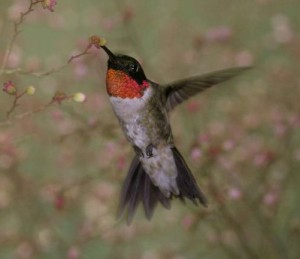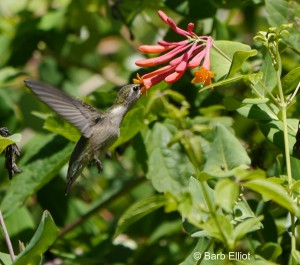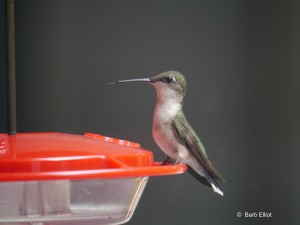By Edie Parnum
I watch my Ruby-throated Hummingbirds obsessively. Beginning in early May flashes of iridescent green zip around my yard. These tiny sprites hover, fly straight up, down, and even backwards. When the light is just so, I can glimpse the male’s dazzling red gorget. I’ve seen that red innumerable times, but I’m always mesmerized.
When I hear a zippety-tzit sound, I know that my territorial male is chasing another hummer away from the flowers or feeders. My male often watches for competitors from his favorite perch, usually a small, but conspicuous, horizontal branch. Like other hummers, he uses a perch to watch for tiny flying insects (an important source of protein), then snags them in mid-air. On occasion I’ve seen the resident male dive up and down in a pendulum swing for the benefit of a female.
I refer to them as “my” hummingbirds, but they’re not mine at all. True, they feed at my feeders, which I assiduously clean and fill with fresh sugar water every few days. They visit the flowers I’ve planted for them–Trumpet Honeysuckle, Trumpet Vine, Bee Balm, Cardinal Flower, Great Blue Lobelia, and Wild Columbine. Ruby-throats are not particularly shy, sometimes feeding or hovering just a few feet from me. Once, a hummer tried to get nectar from a pink flower on my shirt. Another time when one fed just a few feet in front of me, I could see its hyper-fast heart beats (1200 beats per minute while feeding). Nevertheless, most of their lives are unknown to me.
Even though I watch intently, I catch only brief glimpses. Often one will zip behind the deck railing or some leaves, where my view is obscured. Or it simply vanishes. I try to count the number in my yard. I can usually spot two or three, but know that there are probably more during midsummer. I’ve never seen a pair mate. I’ve never seen a female build a nest, incubate eggs, or feed nestlings in my yard. After all, they are wild creatures and don’t live their lives for my amusement. They elude me.
Soon my resident hummingbirds will be gone. Because the adult males take no part in raising the young, they start migrating in the latter part of July. The local females and young soon follow. During August and September the hummingbirds I see in my yard come from the north. I persist in thinking of these migrants as mine, too, since hummingbirds evidently use the same stop-over feeding areas year after year.
Usually I don’t see any hummers in my yard after the third week in September. By then, I no longer have illusions of ownership. I won’t see them on their non-stop 600-mile trip across the Gulf of Mexico. And only if I take an unexpected trip to southern Mexico or Central America will I see them during the winter months. More likely I’ll be deprived of hummingbirds for seven months. However, I’ll welcome my hummingbirds back to my yard next spring—indeed, some will be the same birds.
~ ~ ~ ~ ~ ~ ~ ~ ~ ~ ~ ~ ~ ~ ~ ~ ~ ~ ~ ~ ~ ~ ~ ~ ~ ~ ~ ~ ~ ~ ~ ~ ~ ~ ~ ~ ~ ~ ~ ~ ~ ~
For information about how to attract hummingbirds to your yard and more fascinating facts about them, click here.




Wonderful Edie. Hummers, and their antics, have to be the ultimate backyard bird.
Edie, saw only one hummer on my very recent trip to southern Quebec, and it was feeding on Trumpet Honeysuckle, one of the native plants they feed on in your yard.
Great article,
Joe
Edie;
As usual, great write up. Our hummer feeder is right outside our kitchen window, so we get to see them all the time. My wife (Bebe) is not really a birder, but she loves “our” hummers and has taken on the changing of the sugar water. Unlike most years, the female seems to be the bully around the feeder, and she watches it carefully, and the beautiful (but wimpy) male only gets to feed when she is off foraging elsewhere. It still amazes me how the hummers return to our home almost on the exact same day at the end of April each year. Like you, I never tire of watching these little jewels of the avian world.
I had my first Ruby-throated Hummer of the fall in my yard this past Friday. A female/immature was feeding on a Canna Bulb bloom! That red sure attracts them. They are so much fun to watch – when I can – gee, they move so quick!
Great post, Edie. Thanks. Last month a female hummer surprised me by coming regularly to the white flowers of my sweet pepper bush, Clethra alnifolia, when it was in full fragrant bloom.
They love honeysuckle indeed! I also planted pineapple sage in containers on my deck. They go from one plant to the other.
As always your article was inspiring.
I feel the same sense of ownership. I’ve had great activity at my feeders this summer. Great pix!
Lynne